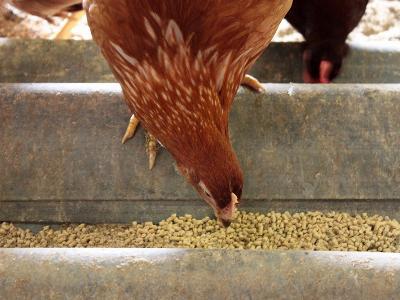New developments in layer hen feeding

Ioannis Mavromichalis, Ph.D., gives his views on poultry, pig and dairy nutrition based on his experience as a nutrition consultant with clients around the world.
Photo by Andrea Gantz
A new method has been proposed that adapts the normal behavior of the hen to the requirements of modern farming.
A single diet offered during the early hours of the light period with some source of calcium top-dresses during the afternoon is the standard feeding program for layers worldwide. Yet a new method has been proposed that adapts the normal behavior of the hen to the requirements of modern farming. This method, called split feeding, is based on the principle that two feeds can be offered, one in the morning and another in the afternoon, at different quantities and with different nutrient composition. The morning feed focuses on the protein and energy requirements of the hen, whereas the afternoon feed focuses on the calcium requirement that coincides with eggshell formation.
In preliminary studies, hens in split-feeding regimens consumed slightly less nutrients and eggshell quality remained strong or improved. Thus, not only was normal feeding behavior allowed, but profitability increased if we discount the extra cost of logistics for the second feed. This reduction in nutrient intake can have further positive consequences in terms of reduced nitrogen and phosphorus excretion and less stress on the hen coming from the excessive consumption of calcium needed to sustain eggshell quality, especially during the late laying period.
Of course, this system remains in the experimental stage as more work is needed to verify and fine-tune the details of each feed, but it appears to be a promising development. In addition, the logistics of the second feed currently prohibit the incorporation of this novel method into most existing facilities, but this is something that can be resolved, or included, in the design of new facilities. Nevertheless, it is something that requires attention.
For more information, the read the relevant proceedings from the 2016 Poultry Federation Conference.
Ioannis Mavromichalis, Ph.D., is Nutrition Editor for WATTAgNet and Editor-in-Chief of Pig International
Related news
 Three-in-one probiotic offers interactive benefits for poultry
Three-in-one probiotic offers interactive benefits for poultry Poultry farmers wanting to boost productivity and safeguard animal health, while minimizing the use of antibiotics
 Threonine key nutrient in lower protein broiler diets: researcher
Threonine key nutrient in lower protein broiler diets: researcher There is a trend for lower crude protein (CP) diets in animal production in the Netherlands, says a poultry expert based at Schothorst Feed Research.
 Supplemental arginine may offer health, production boost to farmed turkey
Supplemental arginine may offer health, production boost to farmed turkey Adding arginine to the diets of farmed turkeys may improve gut health and weight gain, while supporting blood quality, say researchers.
 New poultry research facility aims to improve bird welfare, consumer confidence
New poultry research facility aims to improve bird welfare, consumer confidence A new state-of-the art poultry facility offering specialty, industry-focused research into both laying hen and broiler health, welfare, behavior
 Sodium butyrate has benefits for birds with necrotic enteritis: study
Sodium butyrate has benefits for birds with necrotic enteritis: study Microencapsulated sodium butyrate (MSB) supplementation enhanced intestinal barrier function of broiler birds challenged with necrotic enteritis